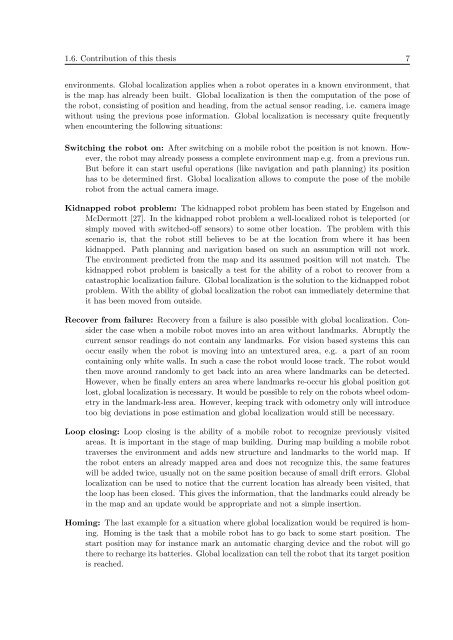PHD Thesis - Institute for Computer Graphics and Vision - Graz ...
PHD Thesis - Institute for Computer Graphics and Vision - Graz ...
PHD Thesis - Institute for Computer Graphics and Vision - Graz ...
Create successful ePaper yourself
Turn your PDF publications into a flip-book with our unique Google optimized e-Paper software.
1.6. Contribution of this thesis 7<br />
environments. Global localization applies when a robot operates in a known environment, that<br />
is the map has already been built. Global localization is then the computation of the pose of<br />
the robot, consisting of position <strong>and</strong> heading, from the actual sensor reading, i.e. camera image<br />
without using the previous pose in<strong>for</strong>mation. Global localization is necessary quite frequently<br />
when encountering the following situations:<br />
Switching the robot on: After switching on a mobile robot the position is not known. However,<br />
the robot may already possess a complete environment map e.g. from a previous run.<br />
But be<strong>for</strong>e it can start useful operations (like navigation <strong>and</strong> path planning) its position<br />
has to be determined first. Global localization allows to compute the pose of the mobile<br />
robot from the actual camera image.<br />
Kidnapped robot problem: The kidnapped robot problem has been stated by Engelson <strong>and</strong><br />
McDermott [27]. In the kidnapped robot problem a well-localized robot is teleported (or<br />
simply moved with switched-off sensors) to some other location. The problem with this<br />
scenario is, that the robot still believes to be at the location from where it has been<br />
kidnapped. Path planning <strong>and</strong> navigation based on such an assumption will not work.<br />
The environment predicted from the map <strong>and</strong> its assumed position will not match. The<br />
kidnapped robot problem is basically a test <strong>for</strong> the ability of a robot to recover from a<br />
catastrophic localization failure. Global localization is the solution to the kidnapped robot<br />
problem. With the ability of global localization the robot can immediately determine that<br />
it has been moved from outside.<br />
Recover from failure: Recovery from a failure is also possible with global localization. Consider<br />
the case when a mobile robot moves into an area without l<strong>and</strong>marks. Abruptly the<br />
current sensor readings do not contain any l<strong>and</strong>marks. For vision based systems this can<br />
occur easily when the robot is moving into an untextured area, e.g. a part of an room<br />
containing only white walls. In such a case the robot would loose track. The robot would<br />
then move around r<strong>and</strong>omly to get back into an area where l<strong>and</strong>marks can be detected.<br />
However, when he finally enters an area where l<strong>and</strong>marks re-occur his global position got<br />
lost, global localization is necessary. It would be possible to rely on the robots wheel odometry<br />
in the l<strong>and</strong>mark-less area. However, keeping track with odometry only will introduce<br />
too big deviations in pose estimation <strong>and</strong> global localization would still be necessary.<br />
Loop closing: Loop closing is the ability of a mobile robot to recognize previously visited<br />
areas. It is important in the stage of map building. During map building a mobile robot<br />
traverses the environment <strong>and</strong> adds new structure <strong>and</strong> l<strong>and</strong>marks to the world map. If<br />
the robot enters an already mapped area <strong>and</strong> does not recognize this, the same features<br />
will be added twice, usually not on the same position because of small drift errors. Global<br />
localization can be used to notice that the current location has already been visited, that<br />
the loop has been closed. This gives the in<strong>for</strong>mation, that the l<strong>and</strong>marks could already be<br />
in the map <strong>and</strong> an update would be appropriate <strong>and</strong> not a simple insertion.<br />
Homing: The last example <strong>for</strong> a situation where global localization would be required is homing.<br />
Homing is the task that a mobile robot has to go back to some start position. The<br />
start position may <strong>for</strong> instance mark an automatic charging device <strong>and</strong> the robot will go<br />
there to recharge its batteries. Global localization can tell the robot that its target position<br />
is reached.















